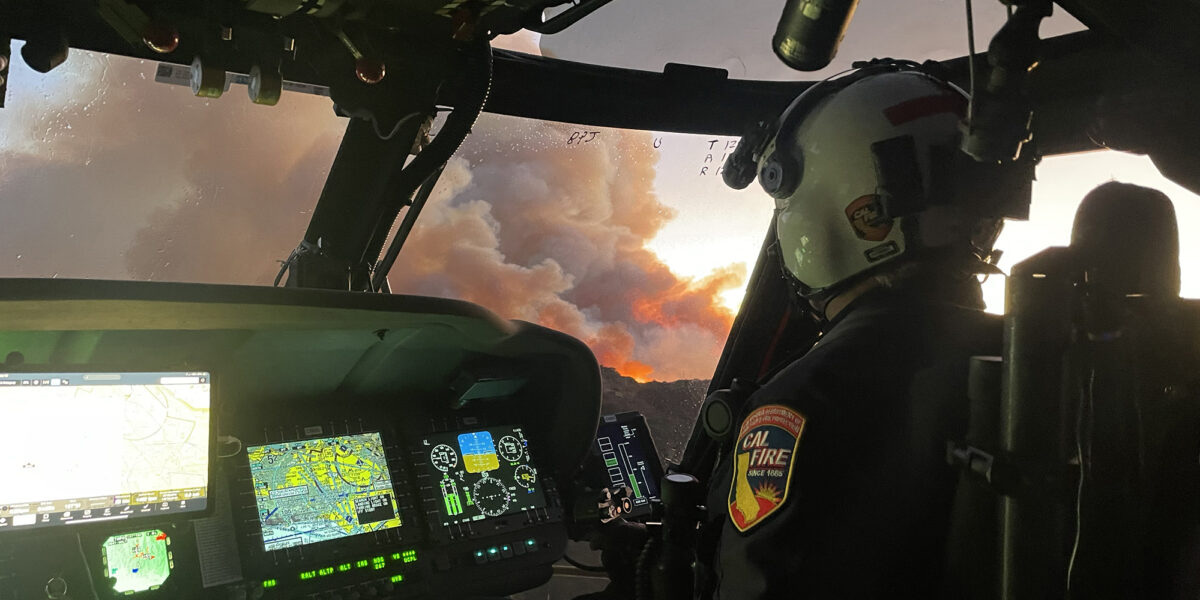
A Helicopter Firefighter’s View From Above
A Cal Fire Battalion Chief describes the harrowing first days of fighting the L.A. fires from the cockpit of a state-of-the art helicopter just 50 feet above the flames.

CAL FIRE
Battalion Chief Sean Ketchum has been with the California Department of Forestry and Fire Protection, also known as Cal Fire, since 2001. He’s worked on the ground as a firefighter, driven fire engines, and for the last 10 years, he’s been a front seat captain in a helitack crew. He works in a helicopter known as a Firehawk, which has the same basic frame as a military Black Hawk, but instead of weaponry, it’s loaded with firefighting equipment, including a 1,000-gallon water tank. He worked the night shift for two weeks during the Palisades Fire. He was in the air for five hours each night, and he was part of a team that turned the fire back when, after decimating the Palisades and parts of Malibu, it had spread east, threatening Brentwood, The Getty Center, Encino, and the San Fernando Valley. He and his crew operate out of Los Gatos in Northern California. That’s where he was when he got the call.

CAL FIRE
The fires started on a Tuesday. I was off duty, driving to go play hockey on Wednesday morning, when my partner called and said, “Hey, we’re going to Southern California.” I drove home, grabbed a couple of things, and we left within about a half-hour.
We were assigned to the Palisades Fire, so our helicopter went out probably about 4 o’clock to get a bit of recon of where we were working that night. Came back, got some fuel, put our night vision goggles on, and went back out, right into the Malibu Canyon area. The newer aircraft has more complex mapping and communication systems, so the front seat captain takes a lot of that load off the pilot. Coordinating with our crews, knowing where they’re at and where we can make water drops to assist them because it can be hazardous, especially at night. Drop 5,000 pounds of water on somebody, that can do some damage.
We were assigned to that Pepperdine dip, a reservoir at least 300 feet long by a couple hundred feet wide. We lower down a 12-foot retractable snorkel as we get close to water level. As we’re in the dip trying to pull the water, we’re getting pushed back. Our personnel were telling the pilot, and he’s like, “I know. I’m trying to hold it straight.” That was our first experience of the winds.
Then, trying to fly up and over that first ridge with 800 gallons of water, the winds were intense, just hammering us. Worse than anything I’ve been in, and I’ve been in some fairly turbulent aircraft. That Wednesday night, we only flew about an hour and a half because the winds were so strong. By that time, the fire had burned all the way to the coast. Friday there was a little bit of an onshore wind, which pushed the back end of the fire in the direction you didn’t want it to go. We probably had six helicopters working together near the Mandeville Canyon area on Friday night. Everyone’s flying from the reservoir to the fire, then from the fire to the reservoir. An oval flight path, almost like a racetrack.
All four personnel on board were wearing white phosphor night vision goggles. When you’re looking at an actual flaming front, it can be so bright you don’t need goggles, but then it’s kind of crazy because if you’re looking at a hillside, with a little bit of active fire, but a lot of smoldering, you can see every little ember, and barely see anything with the naked eye.
You definitely get emotionally attached. Because we want to do the best we can, and if we miss… Let’s say we make a drop, and all of it blows into the black, it’s a bummer. That’s a missed opportunity to put out a little more fire, but sometimes, it takes a miss like that to understand what the winds are doing or how the terrain is affecting our drop.
We’re working the edges. You come from the side and work your way toward the head of the fire. If you put a drop in the very center of the head, and extinguish that portion, you’ve created two heads that could burn in different directions. We call that “splitting the head.”
When we’re coming in for a drop, we can get to within 100 feet of the ground, and if you have 30- to 50-foot flame lengths, you can definitely feel the heat. The pilot can’t look straight down as he’s coming in, but our personnel in back can judge the exact moment to make a drop. The operations supervisor may say, “Come a little right.” Then use a countdown, “Three… two… one… drop.”
When you’re looking through the goggles, and you make a good hit, it really darkens down so you can tell, and it definitely feels good. Then you get another tank of water and do it again.
Obviously, a normal winter… We wouldn’t be fighting these kinds of fires in January.
